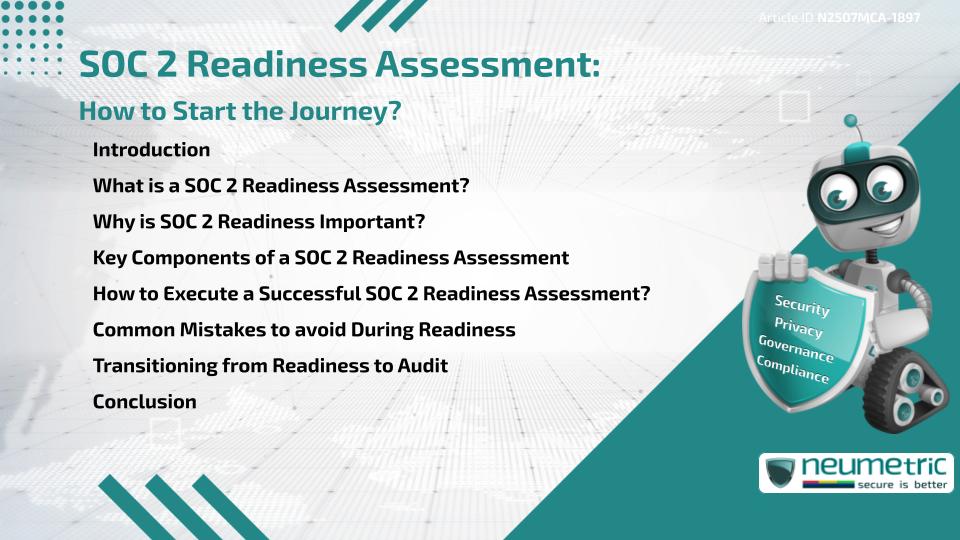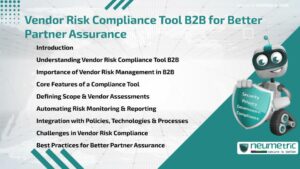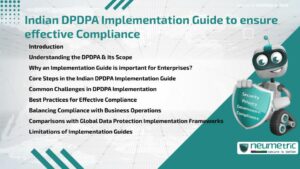Table of Contents
ToggleIntroduction
Preparing for a SOC 2 Audit can seem daunting for any Organisation, especially those handling sensitive Client data. The first crucial step in this journey is a SOC 2 Readiness Assessment, which evaluates your existing systems & processes against the stringent SOC 2 requirements. This phase is not about passing or failing-it is about identifying gaps, maturing your controls & setting a clear path toward compliance.
In this article, we will explore what a SOC 2 Readiness Assessment involves, why it is essential & how to effectively conduct one to lay a strong foundation for your SOC 2 Audit.
What is a SOC 2 Readiness Assessment?
A SOC 2 Readiness Assessment is a diagnostic evaluation designed to determine whether your organisation’s internal controls align with the Trust Services Criteria (TSC): Security, Availability, Processing Integrity, Confidentiality & Privacy.
Rather than being part of the official SOC 2 Audit, it serves as a preliminary internal review–a crucial mock run that prepares your team & infrastructure before an auditor steps in.
Why is SOC 2 Readiness Important?
Skipping the readiness phase can result in Audit delays, higher costs & even non-compliance. A thorough Readiness Assessment offers the following benefits:
- Identifies Control Gaps: Pinpoints weaknesses in your Policies, procedures & systems.
- Saves Time & Cost: Reduces rework & auditor follow-ups during the official Audit.
- Boosts Confidence: Equips Stakeholders with a clear roadmap to certification.
- Improves Security Posture: Helps implement Best Practices & Risk Management strategies.
Key Components of a SOC 2 Readiness Assessment
1. Define the Audit Scope
Start by defining the scope of your SOC 2 Audit:
- What systems, processes & locations are in-scope?
- Which of the five Trust Services Criteria apply to your business?
This clarity helps ensure the Readiness Assessment is focused & efficient.
2. Inventory Existing Controls
Document & evaluate your current controls, including:
- Access management
- Data Encryption
- Incident Response procedures
- Change management
- Vendor Risk Assessments
This inventory sets the baseline for identifying control maturity & alignment with SOC 2 requirements.
3. Conduct a Gap Analysis
This step compares your current state against SOC 2 requirements to identify deficiencies or areas needing improvement. Key questions include:
- Are your Security Policies documented & communicated?
- Do you regularly monitor & log security events?
- Is your Incident Response process tested & effective?
4. Risk Assessment
Evaluate Risks that could impact your systems & Customer Data. A strong Risk Assessment identifies:
- Threat actors
- Potential Vulnerabilities
- Likelihood & impact of Risks
This helps prioritise remediation efforts in the next phase.
5. Remediation Planning
Based on your gap & Risk analysis, create an actionable roadmap. This should include:
- Updating or creating Policies
- Implementing missing controls
- Automating security processes
- Training Employees on compliance practices
How to Execute a Successful SOC 2 Readiness Assessment?
Engage Cross-Functional Teams
SOC 2 impacts IT, HR, legal & operations. Involve all relevant Stakeholders to gain complete visibility & build shared accountability.
Leverage Expert Guidance
Partnering with a SOC 2 consultant or using readiness automation platforms can streamline the process & reduce errors. Their expertise ensures nothing critical is overlooked.
Document Everything
Auditors will need evidence, so start documenting:
- Policies & Procedures
- Security configurations
- Logs & Audit trails
- Risk Assessments & remediation plans
Perform a Readiness Walkthrough
Before finalising the assessment, conduct a walkthrough with Stakeholders. This step ensures everyone understands control objectives, current gaps & the next steps.
Common Mistakes to avoid During Readiness
- Underestimating Time: Readiness can take weeks to months depending on organisational maturity.
- Overlooking Cloud Environments: Ensure Third Party platforms like AWS, Azure or GCP are included.
- Neglecting Employee Training: Human error remains a top Risk; build awareness early.
- Failing to prioritise: Not all controls are equal. Focus on high-impact areas first.
Transitioning from Readiness to Audit
Once the Readiness Assessment is complete & gaps are remediated, you are ready to engage with an independent auditor for your SOC 2 Type I or Type II Audit. A well-documented & structured readiness phase makes this transition seamless & significantly increases your chances of a successful Audit outcome.
Conclusion
Starting your SOC 2 journey with a thorough SOC 2 Readiness Assessment is a strategic move that helps align your security efforts with compliance goals. It allows you to proactively address gaps, reduce Risks & build Stakeholder trust.
Whether you are a startup looking to win enterprise clients or an established SaaS provider aiming to strengthen your controls, a Readiness Assessment is your launchpad to long-term compliance success.
Takeaways
- A SOC 2 Readiness Assessment identifies gaps & aligns your organisation with Trust Services Criteria.
- Scoping, documentation & cross-functional engagement are critical success factors.
- Addressing readiness issues early saves time, money & Audit complications.
- Consultants & automation tools can accelerate the process.
- A well-executed readiness phase builds a solid foundation for SOC 2 Type I or II audits.
FAQs
What is the difference between SOC 2 Readiness & a SOC 2 Audit?
A SOC 2 Readiness Assessment is a self-evaluation that helps your organisation review & improve internal controls before undergoing the actual audit. In contrast, the official SOC 2 audit is conducted by an independent CPA firm & leads to a formal attestation report.
How much time does it take to complete a SOC 2 Readiness Assessment?
The duration of a readiness assessment varies based on how mature your internal systems are & the complexity of your operations. In general, the process can take anywhere from two (2) to twelve (12) weeks.
Can we do a SOC 2 Readiness Assessment ourselves?
Yes, but it is often beneficial to engage a consultant or use a Compliance Tool to ensure a comprehensive review.
Do we need to be fully compliant before the Readiness Assessment?
No. The readiness phase is meant to identify & address non-compliance areas before the actual Audit begins.
Is SOC 2 Readiness mandatory?
It is not required by Auditors but is highly recommended to ensure a smoother & more successful Audit process.
Need help for Security, Privacy, Governance & VAPT?
Neumetric provides organisations the necessary help to achieve their Cybersecurity, Compliance, Governance, Privacy, Certifications & Pentesting needs.
Organisations & Businesses, specifically those which provide SaaS & AI Solutions in the Fintech, BFSI & other regulated sectors, usually need a Cybersecurity Partner for meeting & maintaining the ongoing Security & Privacy needs & requirements of their Enterprise Clients & Privacy conscious Customers.
SOC 2, ISO 27001, ISO 42001, NIST, HIPAA, HECVAT, EU GDPR are some of the Frameworks that are served by Fusion – a SaaS, multimodular, multitenant, centralised, automated, Cybersecurity & Compliance Management system.
Neumetric also provides Expert Services for technical security which covers VAPT for Web Applications, APIs, iOS & Android Mobile Apps, Security Testing for AWS & other Cloud Environments & Cloud Infrastructure & other similar scopes.
Reach out to us by Email or filling out the Contact Form…





